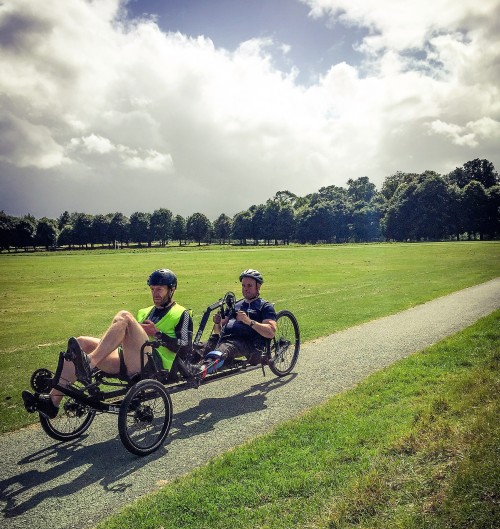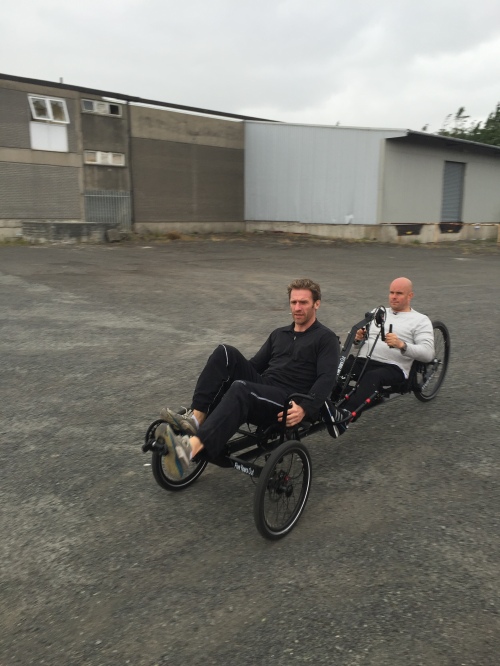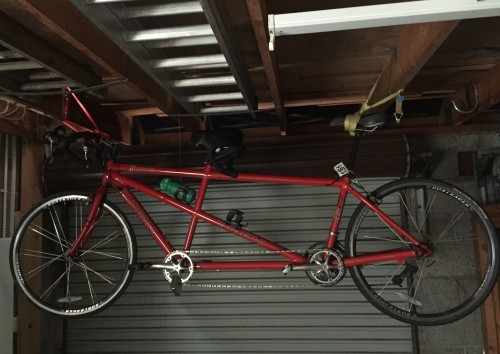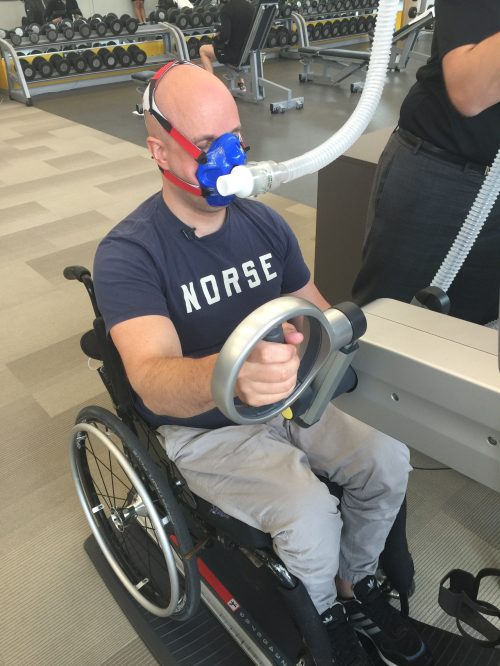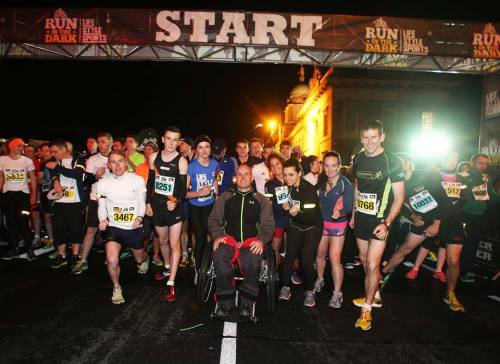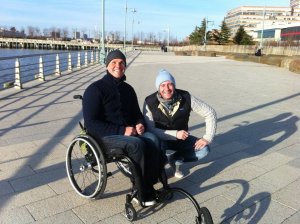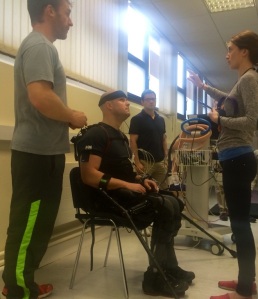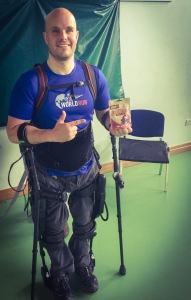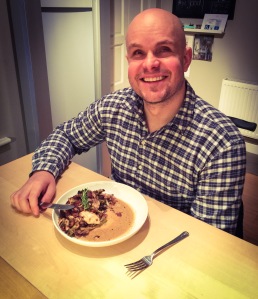#TeamUnbreakable #SmartBike #FastTrackingACure #Paralysis
I was apprehensive as I rolled in my wheelchair onto the scales in the National Rehabilitation Hospital. The screen said 111.3 kilograms for the combined weight of my chair and me. And, as I reversed off the scales and transferred onto a chair, I hoped that my empty wheelchair would weigh at least 30.4 kilograms on it’s own. If it did, then I’d hit 80 kilograms, the target weight I’d set for myself back in April at the start of my training for the Giant’s Causeway Coast Sportive on the 10 September – my first sports challenge since becoming paralysed.
My care assistant, Noel, weighed my empty wheelchair and its 30.7 kilograms meant that after 20 weeks of training and a pretty consistent high fat low carbohydrate diet I’ve dropped about 6.5 kilograms (nearly a stone).
Until my late twenties I seemed to be able to eat whatever I wanted and not put on weight. In 2002 I raced at the Commonwealth Games as a 70 kilo lightweight rower, but 5 years later, as I trained for Ironman Zurich, I had put on a whopping 20 kilos (over 3 stone). And, with recurring achilles tendon injuries stemming from my calf muscles being too weak to carry my growing frame, I was embarrassingly sent to buy Brooks Beast running shoes. They’re specifically designed for the heavier athlete as they spread the weight through a larger sole to avoid injury. None of it – the weight, the shoes or the injuries – were fitting of an aspiring endurance athlete.
In those days of running, cross-country skiing, cycling and kayaking thousands of miles across deserts, up mountains and to the Poles I learned that I could not out-train a bad diet. No matter how hard I exercised, the quality and quantity of what I ate affected my weight. Now, despite having completed more than 160 training sessions over the last 20 weeks that is still the truth. I split the training between walking in my robotic legs in combination with electrical stimulation of my spinal cord, indoor hand biking in the gym, functional weight training and in recent weeks we’ve been cycling in Dublin’s Phoenix Park on our new tandem #smartbike that our incredible sponsors Arrow Electronics delivered.
This training is certainly effecting my evolving body composition. Since I broke my back, my life is largely sedentary – I sit in my wheelchair, because I am also blind, unable to push myself around the city streets. The only time I move my body is when I am on the tandem handbike or in my robot.
But even this level of exercise – 9 or 10 training sessions per week – is not enough to keep my weight under control. Of course I’ve tried all sorts of “eating less” diets, and also the “being prepared with the right food” diets and there’s of course been the “pretending that I could do without cheese and bacon” diets. But none of them worked for very long. Then last year I was speaking at the Royal College of Surgeons in Ireland at their Faculty of Sports and Exercise Medicine Conference and that all changed.
My slot was immediately before Professor Tim Noakes, the author of great books like, Lore of Running, Challenging Beliefs and Real Meal Revolution. He is a doctor, an Emeritus Professor, a runner and most famously a controversial proponent of high fat low carbohydrate eating. I was in the RCSI early to test my videos for my talk and I headed up to the reception area for a coffee where Tim was sitting. I’d spent the previous 2 months following his high fat low carbohydrate eating plan after hearing about it in an audio book called Natural Born Heroes and I bombarded him with questions about my new eating regime, his eating regime.
We were drinking black coffee. Ideally, to fit with Tim’s way of eating, I’d have added some cream, coconut oil or butter but all they had on offer in the cafe was low fat milk, which Tim advises contains too much carbohydrate and too little fat. We discussed the world’s fear of fat and the move over the last 50 years towards a diet heavy in carbohydrates and sugars and with it the western obesity and diabetes crisis. We talked about the mental gymnastics that it takes to park the dogma about what is healthy and what is not.
To learn more directly from Prof. Tim Noakes check out his TEDx Cape town talk at https://www.youtube.com/watch?v=97q1YCXmM9c
Since that conversation last year I’ve been largely sticking to a high fat low carbohydrate diet with only very few forays back to sugar and carbs. And for the last few months I’ve really gone for it and have been getting up and training early with no breakfast. Straight afterwards I’ve been eating a large bacon, mushroom and cheese omelette along with a coffee with cream. During the day I have a second coffee with cream and some days I have some biltong and nuts as a snack. But in recent weeks I just have not been feeling that hungry during the day. In the evenings, thanks to my fiancée Simone’s incredible cooking, I have fatty cuts of meat like lamb, steak, chicken with the skin on or pork chops. And I’ve really upped my vegetable intake helped by being able to have cream sauces and cheese with them – so, cheesey spinach or a Greek salad with feta or rocket and parmesan salad or roasted cauliflower. I’ve struggled to halt all hamburger cravings and sometimes give in to them but I’ve managed to avoid the naan bread and rice when having the odd Indian take away. Simone also makes baseless pizza which is surprisingly tasty and satisfies that post-pub pizza craving.
The point is that moving from a carbohydrate based diet to a vegetable and fat based diet doesn’t feel like a hardship in the way that all the other diets I’ve tried have. The high fat content kills the cravings for sugar and carbs and for eating large quantities. My energy levels are more stable, people keep telling me I look healthier than I have in years and perhaps, most importantly, this Real Meal Revolution way feels like it is a sustainable way of living and eating.
Now as I cycle our #smartbike tandem as part of #TeamUnbreakable I am a lighter, fitter version of my former self. It’s only fair really, because the power that I can contribute with my arms on the back of the tandem is significantly less than the power that Simon contributes with his legs on the front of the bike and I could not bear to have him carry me and heavy at that.
You can check out our training data online thanks to our friends at Microsoft who have created a microsite for the project at
https://teamunbreakable.microsoftcrmportals.com/. Please tweet us, blog about this or share on Facebook using the #SmartBike and #TeamUnbreakable hashtags.

